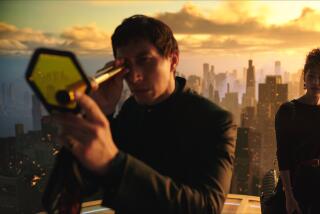MOVIE REVIEWS : Dancing With Dolphins : Costner’s ‘Waterworld’ Exhibits Elements Both Weak and Strong-- but at $175 Million?
“Waterworld” doesn’t come with instructions, but it should. Before entering the theater, take a breath and repeat three times, “It’s only a movie. It’s only a movie. It’s only a movie.”
Because after spending enough money to retire the national debt of a Third World country and generating more publicity than the fall of Rome, it is something of a reality check to discover that this Kevin Costner-starring epic is neither a fiasco nor anything that ina sane universe would have cost $175 million and counting.
Instead, it is a moderately successful guy’s movie with both weak and strong elements where lots of things are brilliantly blown up and few things make any kind of sense. It’s summer business as usual, the classic glass of (yes) water syndrome, either half full or half empty depending on your point of view.
One of “Waterworld’s” cleverest moments is one of its first, when the camera moves in on the Universal Pictures globe logo as its land masses get slowly submerged. This is the future, a narrator tells us, “the polar ice caps have melted, covering the Earth with water. Those who survived have adapted to a new world.”
It’s a world whose people can be divided into strata that roughly correspond to the groups that populate traditional Westerns. Most vulnerable are the unadventurous average citizens, who dream of a perhaps mythical place called Dryland and whose towns are enormous man-made atolls (the one in the movie used 1,000 tons of steel) cobbled together out of random pieces of junk.
Making their lives miserable are the outlaws, here called smokers because they tool around on gas-powered Jet Skis, who live only to terrorize the decent. And then there are the lonely, enigmatic drifters whose relationship to pure good and evil is harder to pin down.
The Mariner, played by Costner, is the drifter’s drifter, the kind of surly, seafaring curmudgeon who eats eyeballs without blinking and brings conviction to lines like “Killing is a hard thing to do well.” He lives alone on his grungy, 60-foot trimaran and spends his life sailing farther, he says, “than most people have dreamed.”
Given that the Mariner is introduced urinating into a jar and then drinking the recycled liquid, this character is not the kind of warm and cuddly hero audiences like best. But the biggest surprise of “Waterworld” has to be what an excellent job Costner does of making this hostile, cold-blooded character both believable and a convincing resident of this bizarre environment.
And, as visualized by production designer Dennis Gassner, with assists from art director David Klassen and visual effects director Peter Chesney, the world the Mariner inhabits ranks with Costner’s performance as one of the film’s most successful creations.
Gassner, an Oscar winner for “Bugsy,” is equally admired for his exemplary work (“Barton Fink” and “The Hudsucker Proxy,” among others) with the Coen brothers. He and his team have come up with what might, with equal justice, be called “Rustworld,” a “Mad Max” on water society typified by that huge atoll, a fierce-looking amalgam of all kinds of scavenged material whose 30-foot walls and impressive gates are meant to keep the rest of the world at bay.
The action highlight of “Waterworld” comes early on, when those pesky smokers, Jet Skis and all, mount an all-out attack on the atoll. Expertly paced and edited, this sequence is alive and energetic, and holds out hope for the rest of the picture that it is not capable of fulfilling.
Given the tangled credit situation on “Waterworld,” with two screenwriters (Peter Rader and David Twohy) named and others uncredited and the final editing coming under Costner’s supervision after director Kevin Reynolds left the picture at the end of April, it is more difficult than usual to know who is responsible for what here. But whoever was at fault, the intensity and interest that “Waterworld” builds up during its first part gradually dissipates as the running time lengthens.
Finding themselves on the Mariner’s trimaran are two characters so generic, it’s amazing the script bothered to give them names. Helen (Jeanne Tripplehorn) is the inevitable woman, essential for looking attractive and saying things like “What’s going on?” Enola (Tina Majorino) is a mouthy little girl Helen has adopted who has the key to the plot tattooed on her back: a strange map that may or may not lead to the mythical Dryland.
While these characters are simply uninteresting, many of the others are downright irritating. Most upsetting of all is Dennis Hopper, inexcusably over the top as Deacon, the leader of the smokers who is painfully determined to get his hands on Enola and her map.
Though “Waterworld” has some haunting underwater visual moments, the film’s impact is weakened by flat dialogue, an overemphasis on jokeyness and a plot that, despite all those screenwriters, does not satisfactorily hold together at any number of points.
Also not making sense is expending this much money on a film where, if the press reports are to be believed, considerable dollars had to be spent shooting simple conversation scenes that, as far as the audience cares, might as well have been done on a sound stage. Yes, verisimilitude is important, but even in Hollywood, shouldn’t cost count for something?
* MPAA rating: PG-13, for some intense scenes of action violence, brief nudity and language. Times guidelines: A small child is placed in continual jeopardy.
(BEGIN TEXT OF INFOBOX / INFOGRAPHIC)
‘Waterworld’
Kevin Costner: Mariner
Dennis Hopper: Deacon
Jeanne Tripplehorn: Helen
Tina Majorino: Enola
Michael Jeter: Gregor
A Universal Pictures and Lawrence Gordon presentation of a Gordon Co./Davis Entertainment Co./Licht/Mueller Film Corp. production, released by Universal. Director Kevin Reynolds. Producers Charles Gordon, John Davis, Kevin Costner. Executive producers Jeffrey Mueller, Andrew Licht, Ilona Herzberg. Screenplay by Peter Rader and David Twohy. Cinematographer Dean Semler. Editor Peter Boyle. Costumes John Bloomfield. Music James Newton Howard. Production design Dennis Gassner. Art director David Klassen. Set decorator Nancy Haigh. Running time: 2 hours, 15 minutes.
* In general release throughout Southern California.
More to Read
Only good movies
Get the Indie Focus newsletter, Mark Olsen's weekly guide to the world of cinema.
You may occasionally receive promotional content from the Los Angeles Times.











